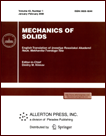 | | Mechanics of Solids
A Journal of Russian Academy of Sciences | | Founded
in January 1966
Issued 6 times a year
Print ISSN 0025-6544
Online ISSN 1934-7936 |
Archive of Issues
| Total articles in the database: | | 13362 |
| In Russian (Èçâ. ÐÀÍ. ÌÒÒ): | | 8178
|
| In English (Mech. Solids): | | 5184 |
|
| << Previous article | Volume 59, Issue 6 / 2024 | Next article >> |
| A.N. Danilin, E.A. Denisov, and V.A. Feldshtein, "Spatial Vibrations of Power Transmission Conductors with Ice Deposits," Mech. Solids. 59 (6), 3360-3374 (2024) |
| Year |
2024 |
Volume |
59 |
Number |
6 |
Pages |
3360-3374 |
| DOI |
10.1134/S0025654424603963 |
| Title |
Spatial Vibrations of Power Transmission Conductors with Ice Deposits |
| Author(s) |
A.N. Danilin (Institute of Applied Mechanics, Russian Academy of Sciences, Moscow, 125040 Russia, andanilin@yandex.ru)
E.A. Denisov (Moscow Institute of Physics and Technology (State University), Dolgoprudny, Moscow Region, 141700 Russia, denisov.egor@phystech.edu)
V.A. Feldshtein (Institute of Applied Mechanics, Russian Academy of Sciences, Moscow, 125040 Russia; Moscow Institute of Physics and Technology (State University), Dolgoprudny, Moscow Region, 141700 Russia, dinpro@mail.ru) |
| Abstract |
The problem on free spatial vibrations of an overhead transmission line conductor with an
asymmetric mass distribution over the cross-section that is caused by ice deposits, which impart an
asymmetric shape to the cross-section, is considered. As a result, an eccentricity between the centers
of torsional stiffness and mass in the cross-section is formed; and a dynamic relation of vertical, torsional, and “pendulum” vibrations develops with the conductor leaving the sagging plane. The conductor is modeled as a flexible heavy elastic rod that resists only stretching and torsion. The case of a
slightly sagging conductor, when the tension and curvature of its centerline can be considered constant
within the span, is investigated. It is also considered that the elasticity of the ice casing is small compared to the elasticity of the conductor. The mathematical model considering the interaction of longitudinal, torsional, and transverse waves polarized in the vertical and horizontal planes is analyzed. The
ratios of phase velocities of all types of waves are analyzed and a group of particular subsystems determining partial vibrations is identified. Partial and natural frequencies and vibration modes of the conductor are investigated. Analytical solutions for the problem on determining the spectrum of natural
frequencies and spatial vibration modes are obtained. The effect of an ice casing on the spectrum of
conductor vibrations is investigated. A dependence of the wave number of torsional vibrations on the
frequency is found. Such a dependence is determined not only by the elastic-inertial, but also by the
gravitational factor, which is strongly manifested for conductors in long spans, especially subjected to
galloping. This circumstance is essential for the analysis of the phenomenon of galloping from the
standpoint of linking the occurrence of galloping with the convergence of the frequencies of torsional
and transverse modes during conductor icing. It is shown that the ratio of these frequencies causing
the self-oscillatory process is considerably complicated. |
| Keywords |
power transmission, conductor, ice deposits, vibrations, waves, frequencies, vibration modes |
| Received |
26 May 2024 | Revised |
16 July 2024 | Accepted |
25 July 2024 |
| Link to Fulltext |
|
| << Previous article | Volume 59, Issue 6 / 2024 | Next article >> |
|
 If you find a misprint on a webpage, please help us correct it promptly - just highlight and press Ctrl+Enter If you find a misprint on a webpage, please help us correct it promptly - just highlight and press Ctrl+Enter
|
|

 Russian
Russian  English
English